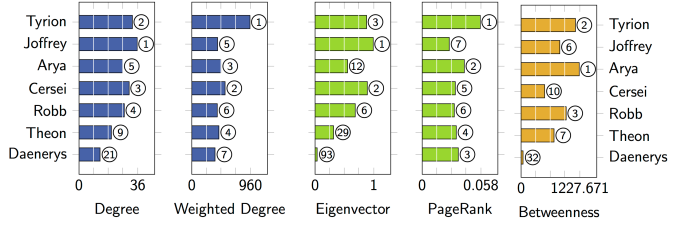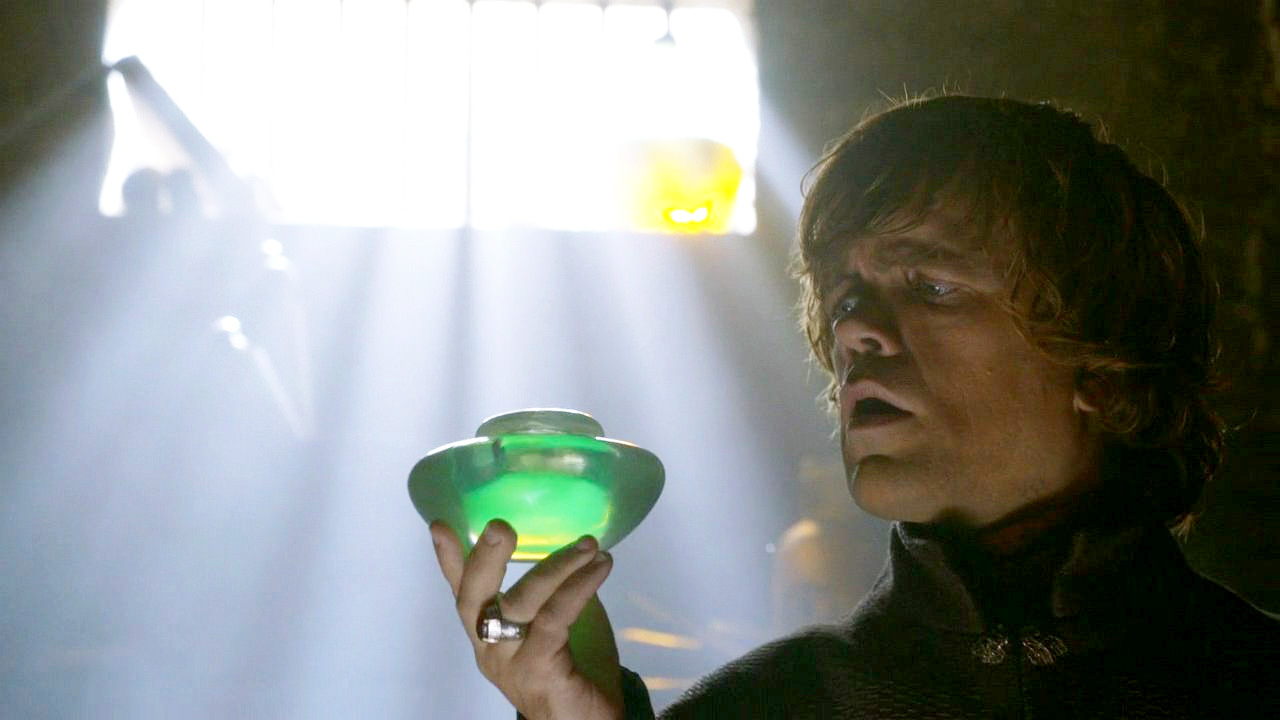
- If you are new to Network Science, be sure to read A Primer on Network Analysis before continuing.
- Spoiler Warning: the text below does make reference to events in various seasons. But looking at the diagrams will tell you a bit about who is “important” without revealing details.
The Network
The Season 2 network has 129 nodes (characters) and 486 weighted edges, corresponding to 6,166 interactions. Character names are sized by PageRank centrality. Character nodes are sized by betweenness centrality. Edge thickness corresponds to edge weight.

Compared to the Season One network, this one has a much stronger community structure. With Ned and Robert out of the picture, the dynamics have fractured. The Starks are spread across five communities (rather than three). In fact, the network is truly fragmented: Daenerys and her Essos community are isolated from the rest of the characters. Meanwhile, Jon’s community north of the Wall all but disconnected from the rest of the network.
Communities
The network splits into six communities. The are (clockwise from the top):
- the Far North (Jon, Sam)
- the Red Waste and Qarth (Daenerys)
- King’s Landing (Tyrion, Joffrey, Cersei)
- Harenhall (Arya, Tywin)
- the Riverlands and the Stormlands (Robb, Catelyn, Stannis, Jaime)
- the Iron Islands and Winterfell (Theon, Bran)
Interestingly, the main hub in each community does not have many strong ties beyond the community. For example Tywin has more ties beyond the Harrenhall community than Arya does. The lack of connections between the focal points reflects the shattered nature of the narrative.
The Essos community has the simplest structure, revolving around Daenerys. The Far North organizes around Jon Snow, with particularly strong ties to Ygritte and Qhorin. Sam acts as a secondary hub for the Night’s Watchmen at Craster’s Keep. The Ironborn/Winterfell community has a comparable structure, with Theon and Bran playing the primary and secondary roles. The Harenhall community also has two hubs: Arya and Tywin. However, their roles are quite different: Arya ties the community together, while Tywin provides strong connections beyond Harenhall, particularly to King’s Landing.

The two larger communities have a far more complex structure. Tyrion is the clear focus of the King’s Landing community. His rivalry with Cersei anchors the dynamics in the capitol city. The Lannister siblings interact more with one another than either does with Joffrey, indicating where the true power of the Throne is being wielded from. Cersei, Joffrey and Sansa form another notable triangle. Tyrion has strong, but independent, connections to Shae, Bronn and Varys. Meanwhile, Littlefinger is well-situated between communities, connecting to Lannisters, Starks, Baratheons and Tyrells.
The Riverlands/Shadowlands community is the most unwieldy, reflecting the uneasy coalitions and rivalries that have erupted due to the deaths of Ned and King Robert. Catelyn glues this community together, as she tries to negotiate these would-be kings behind a common cause. This community features a few important and interlocking triangles: Robb/Catelyn/Jaime, Catelyn/Brienne/Jaime, Catelyn/Brienne/Renly, Renly/Stannis and Stannis/Davos/Melisandre. This linked chain captures the evolving alliances and tensions as the season unfolds.
Centrality Measures

Degree centrality identifies Arya, Cersei, Joffrey, Robb and Tyrion as the top characters. This is quite a reversal from Season One where Tyrion was the only Lannister to make the grade. Tyrion and Cersei battle over Joffrey and the direction of the Seven Kingdoms. (Of course, Tyrion also battles with himself.) Weighted degree tells a slightly different story, with Theon (poetically?) unseating Robb for fourth place.
The Lannisters dominate eigenvector centrality which seems focused on the battle for the Iron Throne. Joffrey scores highest, even though he does not have as many interactions as the other top characters. Joffrey gets this boost from the attention of the important characters beyond King’s Landing who vie for his throne. Cersei and Tyrion come next, followed by Stannis Baratheon, Tywin and Robb Stark in sixth place.

Tyrion handily wins PageRank centrality, but it is the runners-up who are most notable. Arya, Daenerys and Theon best the more connected Cersei, Joffrey and Robb, showing the complexity of the interweaving plotlines. Arya follows a perilous journey that has her hiding in plain sight, under the nose of Tywin Lannister, and her inconspicuous importance is nicely illustrated by her low eigenvector centrality compared to her high PageRank score. She provides a remarkable view on the Lannister patriarch: a masterful strategist and uncompromising leader. Daenerys faces great hardship, while Theon tries to prove himself to his father, Balon by seizing Winterfell.
Tywin heads the second tier of characters, which also includes Stannis, Theon, Catelyn, Sansa and Littlefinger. Stalwart and righteous, Stannis grapples with great turmoil, betrayed by the Lannisters and by his own brother Renly, who attempts to jump the line of succession. Theon’s storyline launches in earnest: he connects the Iron Islands to Winterfell in a brutal and inauspicious manner, arrogantly trying to live up to (or perhaps down to) his family’s expectations. Turning to the other Stark women, Catelyn provides wise council to her son Robb, balancing his fierce personality with savvy statesmanship. Meanwhile, Sansa is in over her head and directionless, cut off from her family and held hostage in betrothal. Littlefinger’s eigenvector centrality singles out his strong network connections across communities, including notable ties to Catelyn, Margaery, Tywin, Cersei and Tyrion. No other character ties together the threads like he does, yet is betweenness is quite low. This is how Lord Baelish likes to operate: unnoticed and underestimated.
Even more than in Season One, Daenerys and Jon are diminished by their remote locales. With the death of King Robert and execution of Ned Stark, no one in Westeros has time to think about the beggar queen, who finds herself at a personal low and in a small network entirely disconnected from the main Westerosi network. Meanwhile, Jon is lost to the wildings beyond the wall, garnering as little attention as a bastard son deserves. By narrative conventions, a viewer knows that, eventually, their arduous journeys should lead to transformative moments. But this network captures their lack of significance in the here and now.
And the Winner Is…
Degree centrality and eigenvector centrality identify the churlish Joffrey as the most important character in Season Two. However, his poor showings in the other three categories reveal Joffrey as the facade that he is.

It is Tyrion who deserves the MVP crown. The Imp’s performance is consistently superior, whereas every other character shows weakness in some category. In particular, Tyrion dominates weighted degree centrality, almost doubling the performance of second-place Cersei. Joffrey comes in fifth, behind Arya and Theon as well. Tyrion, the most fully developed character of the season, transforms from drunkard to statesman— well, drunk statesman, anyway.

Complementing the interesting PageRank ordering, the top betweenness performers are Arya, Tyrion, Robb and Jon. They embody the true threads that the season weaves. King Joffrey is simply the face of the political conflict.